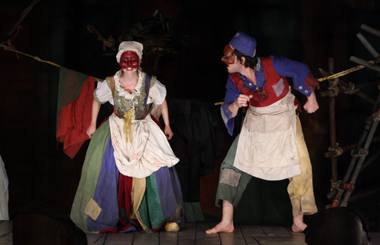What is commedia dell’arte? How was it really played? Was Harlequin really an important character or was he just a Zanni among many? Pantalone, was he really Venetian? Who is Tartaglia? Is Pierrot part of the commedia dell’arte? And why did Dario Fo say that Commedia dell’arte never existed? How to separate myth and reality?
And if the real commedia dell’arte was the one behind the mask, in us?
THE TRADITION
This 32-hour course will allow participants to confront the so-called “traditional” commedia dell’arte by learning the basic positions of the fundamental archetypes of Italian comedy.
THE TREATRISE
Once this “tradition” is memorized, the participants will be invited to move away from it in order to try to find through the strength of the masked acting all the truth and the accuracy of the Italian comedy.
THE CHALLENGE
The challenge of this internship is to succeed in getting rid of stubborn clichés that stick too often to the skin of this kind of theatrical (grimaces, cabotinages and excessive tumbles). Participants will try to find the urgency of the fairground actor behind the mask, the correctness of the body before the posture, the good pace before the choreography, the truth before the grimace.
They will discover a theater that is both complex and playful, codified and free, demanding and exhilarating. The work will oscillate between the precision of the pace and the body and the freedom of improvisation and play.
THE DESCENDANTS
A great Western tradition, the commedia dell’arte has inspired a large number of authors who have, consciously or not, paid homage to it by creating characters who are true descendants of the “maschere”.
Indeed, is not Shylock a Venetian merchant like Pantalone? If Cyrano has the nose of the Capitan, does our Quebec Fridolin have as much ardor as Arlequin? And Michel Tremblay’s Therese , waitress badly shrieked if it is one, is she not a distant little cousin of the fiery and smart servant Columbine?
Block 1: History and initiation to the game of the mask
Block 2: The Zannis
Harlequin of course, but also Brighella, Colombine, Smeraldina and the ugly Polichinelle.
Block 3: The old
Pantalone and its friend the Doctor.
Block 4: The lovers
The lovers but also the “second lovers or lovers rats” Pierrot and Tartaglia.
Block 5: Foreigners
Capitan and Signora (and her servant, Infarinato)
Block 6: Canvas work and choice of short monologue for the “descendants”.
Quick review of the different archetypes and canvas work.
Block 7: Continuation of the Canvas Work
Precision work on the characters from canvas work with masks, costumes and accessories.
Block 8: Presentation of “descendants” and exit
Work on the monologues of the “descendants” and final presentation of the canvases. If the weather permits, the “troupe” will be invited to perform as in the golden age of the theater.
Duration of the workshop: 32h (8 blocks of 4h)
Number of participants maximum: 12
Workshop designed for professional actors
Available in all regions (transportation or accommodation costs may be approved)
Contact: ateliers@toutatrac.com

